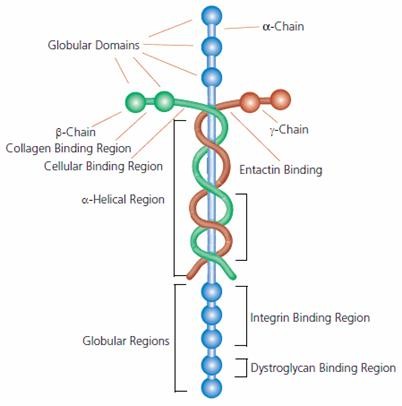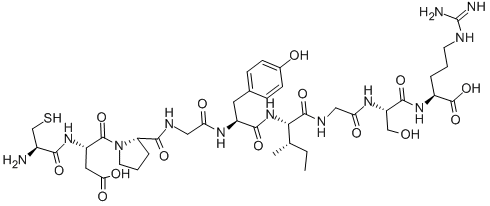Laminin (925-933)Extracellular matrix glycoprotein CAS# 110590-60-8 |

- Cadherin Peptide, avian
Catalog No.:BCC1018
CAS No.:127650-08-2
- Epidermal Growth Factor Receptor Peptide (985-996)
Catalog No.:BCC1014
CAS No.:96249-43-3
Quality Control & MSDS
3D structure
Package In Stock
Number of papers citing our products

| Cas No. | 110590-60-8 | SDF | Download SDF |
| PubChem ID | 9811758 | Appearance | Powder |
| Formula | C40H62N12O14S | M.Wt | 967.06 |
| Type of Compound | N/A | Storage | Desiccate at -20°C |
| Solubility | H2O Peptide Solubility and Storage Guidelines: 1. Calculate the length of the peptide. 2. Calculate the overall charge of the entire peptide according to the following table: 3. Recommended solution: | ||
| Sequence | H2N-Cys-Asp-Pro-Gly-Tyr-Ile-Gly-Ser-Arg-OH | ||
| Chemical Name | (2S)-2-[[(2S)-2-[[2-[[(2S,3S)-2-[[(2S)-2-[[2-[[(2S)-1-[(2S)-2-[[(2R)-2-amino-3-sulfanylpropanoyl]amino]-3-carboxypropanoyl]pyrrolidine-2-carbonyl]amino]acetyl]amino]-3-(4-hydroxyphenyl)propanoyl]amino]-3-methylpentanoyl]amino]acetyl]amino]-3-hydroxypropanoyl]amino]-5-(diaminomethylideneamino)pentanoic acid | ||
| SMILES | CCC(C)C(C(=O)NCC(=O)NC(CO)C(=O)NC(CCCN=C(N)N)C(=O)O)NC(=O)C(CC1=CC=C(C=C1)O)NC(=O)CNC(=O)C2CCCN2C(=O)C(CC(=O)O)NC(=O)C(CS)N | ||
| Standard InChIKey | NGBBIWFVAWMQKZ-JDIVNGTKSA-N | ||
| Standard InChI | InChI=1S/C40H62N12O14S/c1-3-20(2)32(37(63)46-17-30(56)48-27(18-53)35(61)49-24(39(65)66)6-4-12-44-40(42)43)51-34(60)25(14-21-8-10-22(54)11-9-21)47-29(55)16-45-36(62)28-7-5-13-52(28)38(64)26(15-31(57)58)50-33(59)23(41)19-67/h8-11,20,23-28,32,53-54,67H,3-7,12-19,41H2,1-2H3,(H,45,62)(H,46,63)(H,47,55)(H,48,56)(H,49,61)(H,50,59)(H,51,60)(H,57,58)(H,65,66)(H4,42,43,44)/t20-,23-,24-,25-,26-,27-,28-,32-/m0/s1 | ||
| General tips | For obtaining a higher solubility , please warm the tube at 37 ℃ and shake it in the ultrasonic bath for a while.Stock solution can be stored below -20℃ for several months. We recommend that you prepare and use the solution on the same day. However, if the test schedule requires, the stock solutions can be prepared in advance, and the stock solution must be sealed and stored below -20℃. In general, the stock solution can be kept for several months. Before use, we recommend that you leave the vial at room temperature for at least an hour before opening it. |
||
| About Packaging | 1. The packaging of the product may be reversed during transportation, cause the high purity compounds to adhere to the neck or cap of the vial.Take the vail out of its packaging and shake gently until the compounds fall to the bottom of the vial. 2. For liquid products, please centrifuge at 500xg to gather the liquid to the bottom of the vial. 3. Try to avoid loss or contamination during the experiment. |
||
| Shipping Condition | Packaging according to customer requirements(5mg, 10mg, 20mg and more). Ship via FedEx, DHL, UPS, EMS or other couriers with RT, or blue ice upon request. | ||

Laminin (925-933) Dilution Calculator

Laminin (925-933) Molarity Calculator

Calcutta University

University of Minnesota

University of Maryland School of Medicine

University of Illinois at Chicago

The Ohio State University

University of Zurich

Harvard University

Colorado State University

Auburn University

Yale University

Worcester Polytechnic Institute

Washington State University

Stanford University

University of Leipzig

Universidade da Beira Interior

The Institute of Cancer Research

Heidelberg University

University of Amsterdam

University of Auckland

TsingHua University

The University of Michigan

Miami University

DRURY University

Jilin University

Fudan University

Wuhan University

Sun Yat-sen University

Universite de Paris

Deemed University

Auckland University

The University of Tokyo

Korea University
Laminin (925-933) is a peptide(Cys-Asp-Pro-Gly-Tyr-Ile-Gly-Ser-Arg) derived from residues 925-933 of the laminin B1 chain that binds to the laminin receptor.
Laminins, a family of extracellular matrix glycoproteins, are the major noncollagenous constituent of basement membranes. They have been implicated in a wide variety of biological processes including cell adhesion, differentiation, migration, signaling, neurite outgrowth and metastasis. Laminins are composed of 3 non identical chains: laminin alpha, beta and gamma (formerly A, B1, and B2, respectively)
The laminin beta 1 chain has 7 structurally distinct domains, which it shares with other beta chain isomers. Laminin, beta 1 is expressed in most tissues that produce basement membranes, and is one of the 3 chains constituting laminin 1, the first laminin isolated from Engelbreth-Holm-Swarm (EHS) tumor. A sequence in the beta 1 chain that is involved in cell attachment, chemotaxis, and binding to the laminin receptor was identified and shown to have the capacity to inhibit metastasis.

Figure1 Structure of Laminin

Figure2 Formula of LamininB1 (925-933)
Ref:
1.Ikonen J, Pikkarainen T, Savolainen ER, Tryggvason K (Feb 1989). "A Hpa I polymorphism in the human laminin B1 chain gene on 7q22". Nucleic Acids Res 17 (1): 473.
2.Roche KB, Moore JW, Surana RB, Wilson BE (May 1989). "Aortic root dilatation associated with partial trisomy 7(q31.2----qter)". Pediatr Cardiol 10 (1): 53–5.
3.Bonneau D, Huret JL, Godeau G, Couet D, Putterman M, Tanzer J, Babin P, Larregue M (Sep 1991). "Recurrent ctb(7)(q31.3) and possible laminin involvement in a neonatal cutis laxa with a Marfan phenotype". Hum Genet 87 (3): 317–9.
- Salermide
Catalog No.:BCC7867
CAS No.:1105698-15-4
- Albrassitriol
Catalog No.:BCN7274
CAS No.:110557-39-6
- Scutebarbatine F
Catalog No.:BCN5377
CAS No.:910099-78-4
- 6,11-Di-O-acetylalbrassitriol
Catalog No.:BCN7273
CAS No.:110538-20-0
- Crotastriatine
Catalog No.:BCN2101
CAS No.:11051-94-8
- BYK 204165
Catalog No.:BCC2449
CAS No.:1104546-89-5
- ML-7 hydrochloride
Catalog No.:BCC1770
CAS No.:110448-33-4
- Dolastatin 10
Catalog No.:BCC4056
CAS No.:110417-88-4
- Gelsemiol
Catalog No.:BCN5992
CAS No.:110414-77-2
- Higenamine HCl
Catalog No.:BCN2831
CAS No.:11041-94-4
- Meclizine hydrochloride
Catalog No.:BCC9017
CAS No.:1104-22-9
- 2,3-Dihydroheveaflavone
Catalog No.:BCN4019
CAS No.:110382-42-8
- human Insulin expressed in yeast
Catalog No.:BCC7689
CAS No.:11061-68-0
- Epimedin A
Catalog No.:BCN1038
CAS No.:110623-72-8
- Epimedin B
Catalog No.:BCN1039
CAS No.:110623-73-9
- Epimedin C
Catalog No.:BCN1040
CAS No.:110642-44-9
- beta-Escin
Catalog No.:BCC8172
CAS No.:11072-93-8
- Asebotin
Catalog No.:BCN7233
CAS No.:11075-15-3
- Garcinexanthone A
Catalog No.:BCN5993
CAS No.:1107620-67-6
- Cinobufotalin
Catalog No.:BCN2283
CAS No.:1108-68-5
- MCOPPB trihydrochloride
Catalog No.:BCC4161
CAS No.:1108147-88-1
- Sparfloxacin
Catalog No.:BCC4848
CAS No.:110871-86-8
- Entrectinib
Catalog No.:BCC6410
CAS No.:1108743-60-7
- Wilforine
Catalog No.:BCN5994
CAS No.:11088-09-8
Synthetic peptides interacting with the 67-kd laminin receptor can reduce retinal ischemia and inhibit hypoxia-induced retinal neovascularization.[Pubmed:11786424]
Am J Pathol. 2002 Jan;160(1):307-13.
The high-affinity 67-kd laminin receptor (67LR) is expressed by proliferating endothelial cells during retinal neovascularization. The role of 67LR has been further examined experimentally by administration of selective 67LR agonists and antagonists in a murine model of proliferative retinopathy. These synthetic 67LR ligands have been previously shown to stimulate or inhibit endothelial cell motility in vitro without any direct effect on proliferation. In the present study, a fluorescently labeled 67LR antagonist (EGF(33-42)) was injected intraperitoneally into mice and its distribution in the retina was assessed by confocal scanning laser microscopy. Within 2 hours this peptide was localized to the retinal vasculature, including preretinal neovascular complexes, and a significant amount had crossed the blood retinal barrier. For up to 24 hours postinjection, the peptide was still present in the retinal vascular walls and, to a lesser extent, in the neural retina. Non-labeled EGF(33-42) significantly inhibited pre-retinal neovascularization in comparison to controls treated with phosphate-buffered saline or scrambled peptide (P < 0.0001). The agonist peptide (Lam beta 1(925-933)) also significantly inhibited proliferative retinopathy; however, it caused a concomitant reduction in retinal ischemia in this model by promoting significant revascularization of the central retina (P < 0.001). Thus, 67LR appears to be an important target receptor for the modulation of retinal neovascularization. Agonism of this receptor may be valuable in reducing the hypoxia-stimulated release of angiogenic growth factors which drives retinal angiogenesis.
Murine epidermal growth factor peptide (33-42) binds to a YIGSR-specific laminin receptor on both tumor and endothelial cells.[Pubmed:8824265]
J Biol Chem. 1996 Oct 18;271(42):26179-86.
A laminin-antagonist peptide, comprising amino acids 33-42 of murine epidermal growth factor (mEGF-(33-42)), interacts with a breast cancer- and endothelial cell-associated receptor, which is specific for the laminin B1 chain sequence, CDPGYIGSR-NH2 (Lam.B1-(925-933)), and is immunologically similar to a previously described 67-kDa laminin receptor. In whole cell receptor assays, mEGF-(33-42), Lam. B1-(925-933), and laminin all have IC50 values for displacement of 125I-laminin in the range 1-5 nM. Cell attachment to solid-phase laminin is also blocked by all three ligands, but in contrast to the receptor assays, mEGF-(33-42) or Lam.B1-(925-933), while equipotent with each other, were less effective than laminin. The concentrations of the peptides required to produce half-maximal inhibition of attachment were in the range 230-390 nM, but those for laminin were 1000-fold lower, in the range 0.2-0.3 nM. Like laminin, solid-phase mEGF-(33-42) supports cell attachment, and this ability is blocked by anti-67-kDa receptor antibodies. Modeling studies suggest that both peptides present a tyrosyl and an arginyl residue on the same face of a right-handed helical fold with elliptical cross-section.
High glucose, high insulin, and their combination rapidly induce laminin-beta1 synthesis by regulation of mRNA translation in renal epithelial cells.[Pubmed:17259394]
Diabetes. 2007 Feb;56(2):476-85.
Laminin is a glycoprotein that contributes to renal extracellular matrix expansion in diabetes. We investigated regulation of laminin-beta1 synthesis in murine renal proximal tubular epithelial cells by 30 mmol/l glucose (high glucose), 1 nmol/l insulin (high insulin), and their combination (high glucose+high insulin), simulating conditions observed during progression of type 2 diabetes. Compared with 5 mmol/l glucose and no insulin (control), high glucose alone, high insulin alone, or high glucose+high insulin together increased laminin-beta1 chain protein synthesis within 5 min, lasting for up to 60 min with no change in laminin-beta1 mRNA levels. Cycloheximide, but not actinomycin-D, abrogated increased laminin-beta1 synthesis. High glucose, high insulin, and high glucose+high insulin stimulated phosphorylation of 4E-BP1, a repressor binding protein for eukaryotic initiation factor 4E (eIF4E), that was dependent on activation of phosphatidylinositol 3-kinase, Akt, and mammalian target of rapamycin. High glucose, high insulin, and high glucose+high insulin also promoted release of eIF4E from 4E-BP1, phosphorylation of eIF4E, and increase in eIF4E association with eIF4G, critical events in the initiation phase of mRNA translation. High glucose, high insulin, and high glucose+high insulin increased Erk phosphorylation, which is an upstream regulator of eIF4E phosphorylation, and PD098059, which is a MEK inhibitor that blocks Erk activation, abolished laminin-beta1 synthesis. This is the first demonstration of rapid increment in laminin-beta1 synthesis by regulation of its mRNA translation by cells exposed to high glucose, high insulin, or high glucose+high insulin.
Murine epidermal growth factor (EGF) fragment (33-42) inhibits both EGF- and laminin-dependent endothelial cell motility and angiogenesis.[Pubmed:7543818]
Cancer Res. 1995 Sep 1;55(17):3772-6.
Laminin, murine epidermal growth factor (mEGF), and the synthetic laminin peptide Lam.B1(925-933) (a linear peptide from the B1 chain of murine laminin, CDPGY1GSR-amide) all stimulate endothelial cell motility above basal rates, whereas a synthetic mEGF fragment, mEGF33-42 (a linear peptide from the C-loop of mEGF, acetyl-C-[S-Acm]-VIGYSGDR-C-[S-Acm]-amide), inhibits motility. In both human SK HEP-1 and embryonic chick endothelial cells, mEGF33-42 blocks both EGF- and laminin-stimulated locomotion of endothelial cells. In vivo, mEGF33-42 also blocks both laminin- and mEGF-induced angiogenesis in the chick. In the human cell line. Lam.B1(925-933) has an additive effect in coincubation with either laminin or mEGF, but it blocks their effects in the chick cells. Lam.B1(925-933) alone stimulates angiogenesis in the chick but blocks laminin-induced angiogenesis. Thus, mEGF33-42 acts as a general laminin antagonist, whereas Lam.B1(925-933) acts as a laminin agonist in human cells, but in chick cells it acts as a partial antagonist. We propose that the presence of an anionic group at the eighth residue of mEGF33-42 may be the source of the antagonistic effects seen with this peptide as compared with the laminin fragment. These findings have important implications in the design of human antiangiogenic agents, and also in the use of chick models in the study of human disease.


